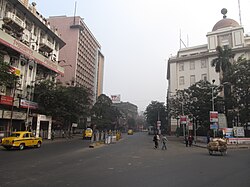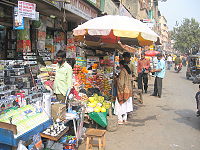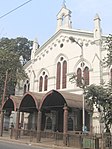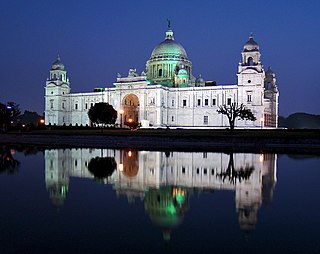
The Maidan, also referred to as the Brigade Parade Ground, is a large public park and urban green space in the center of Kolkata, India. With a total area of 988 acres (4.0 km2), it is the largest urban public park in India. It is a vast stretch of field that includes numerous sporting grounds, including the famous cricketing venue Eden Gardens, several football stadiums and the Kolkata Race Course. The Maidan is also dotted with many statues and architectural works, the most notable being the Victoria Memorial. Due to the freshness and greenery it provides to the metropolis, it has been referred to as the "lungs of Kolkata".
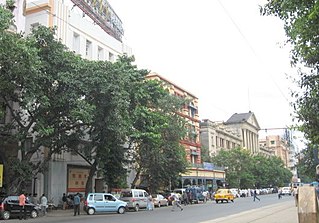
Esplanade is a neighbourhood of Central Kolkata, in Kolkata district in the Indian state of West Bengal. This is not a conventional esplanade in the sense that the place is not exactly situated alongside a waterbody. However, the Ganga river (Ganges), also known as Hooghly river, flows nearby.
Chowringhee Road, located in the Chowringhee neighbourhood of Kolkata, is the arterial road running from the eastern fringes of Esplanade southwards up to the crossing with Lower Circular Road, in the city of Kolkata, West Bengal, India. It is the single most important road of the metropolis of Kolkata. It was officially renamed as Jawaharlal Nehru Road after Jawaharlal Nehru, India's first Prime Minister, but the original name Chowringhee Road is used commonly.

Chowringhee is a neighbourhood of Central Kolkata, in Kolkata district in the Indian state of West Bengal. Chowringhee Road runs on its western side. A neighbourhood steeped in history, it is a business district, as well as a shopper's destination and entertainment-hotel centre.

Kalikata was one of the three villages which were merged to form the city of Kolkata in India. The other two villages were Gobindapur and Sutanuti. Job Charnock, an administrator with the British East India Company is traditionally credited with the honour of founding the city. He settled in the village of Sutanuti.

Gobindapur was one of the three villages which were merged to form the city of Calcutta in late 17th century. The other two villages were Kalikata and Sutanuti. Job Charnock, an administrator with the British East India Company is traditionally credited with the honour of founding the city. While Kalikata and Sutanuti lost their identity as the city grew, Gobindapur was demolished for the construction of new Fort William.

Chitpur is a neighbourhood in North Kolkata in Kolkata district in the Indian state of West Bengal. Sometimes, the entire area along Chitpur Road is referred to as Chitpur, although the various localities have distinctive names.

Kumortuli is a traditional potters' quarter in northern Kolkata, West Bengal, India. The city is renowned for its sculpting prowess. It not only manufactures clay idols for various festivals but also regularly exports them.

Bagbazar is a neighbourhood of North Kolkata, in Kolkata district in the Indian state of West Bengal. The area, under Shyampukur police station of Kolkata Police, has been, along with neighbouring Shyambazar, the citadel of the Bengali aristocracy. Bagbazar has played an active role in growth and development of Kolkata.

Janbazar is a neighbourhood of Central Kolkata, in Kolkata district in the Indian state of West Bengal. The two century-old house of Rani Rashmoni, the central attraction in Janbazar, is still used by descendants in the family.
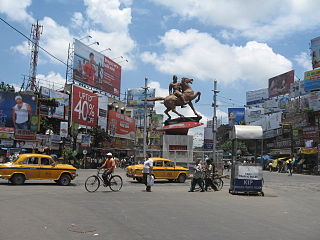
Shyambazar is a neighbourhood of North Kolkata, in Kolkata district in the Indian state of West Bengal. The area, under Shyampukur police station of Kolkata Police, has been, along with neighbouring Bagbazar, the citadel of the Bengali aristocracy, in a part of what was earlier known as Sutanuti. and the popularity of Shyambazer five point crossing is for the statue of Netaji Subhas Chandra Bose.

Bowbazar is a neighbourhood of Central Kolkata, in Kolkata district in the Indian state of West Bengal.
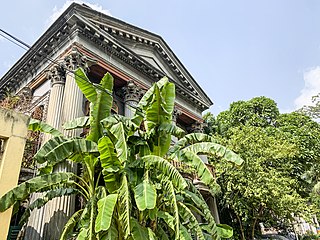
Shyampukur is a neighbourhood of North Kolkata, in Kolkata district in the Indian state of West Bengal. As a neighbourhood, it covers a small area but its importance is primarily because of the police station.

Jorabagan is a neighbourhood of North Kolkata, in Kolkata district, in the Indian state of West Bengal. As a neighbourhood, it covers a small area but its importance is primarily because of the police station.

Taltala is a neighbourhood in Central Kolkata, in Kolkata district in the Indian state of West Bengal. One of the oldest neighbourhoods of the metropolis, it has a police station on its own name.

Chandni Chowk, Kolkata is a metro station of the Kolkata Metro.It is located in Central Avenue, Chandni Chowk, Bowbazar, Kolkata, West Bengal, India.
Sinthee or Sinthi is a neighbourhood of North Kolkata in Kolkata district, West Bengal, India.

The tram system in the city of Kolkata, West Bengal, India, operated by West Bengal Transport Corporation (WBTC) after Calcutta Tramways Company (CTC) was dissolved, is the oldest existing tram network operating in India, and oldest operating tramway in Asia. Started in 1902, it is the second oldest electric tramway in India.
Ward No. 46, Kolkata Municipal Corporation is an administrative division of Kolkata Municipal Corporation in Borough No. 6, covering parts of Chowringhee, Esplanade East, Dharmatala, Janbazar, Lalbazar, Bowbazar and Maidan neighbourhoods in central Kolkata, in the Indian state of West Bengal.
Dihi Panchannagram was a group of 55 villages which the East India Company purchased in 1758 from Mir Jafar, after the fall of Siraj-ud-daulah, the last independent Nawab of Bengal, in what is now the city of Kolkata, earlier known as Calcutta, in Kolkata district, in the Indian state of West Bengal. These villages initially developed as suburbs of Kolkata, but now forms part of the city proper within the limits of the Kolkata Municipal Corporation.
